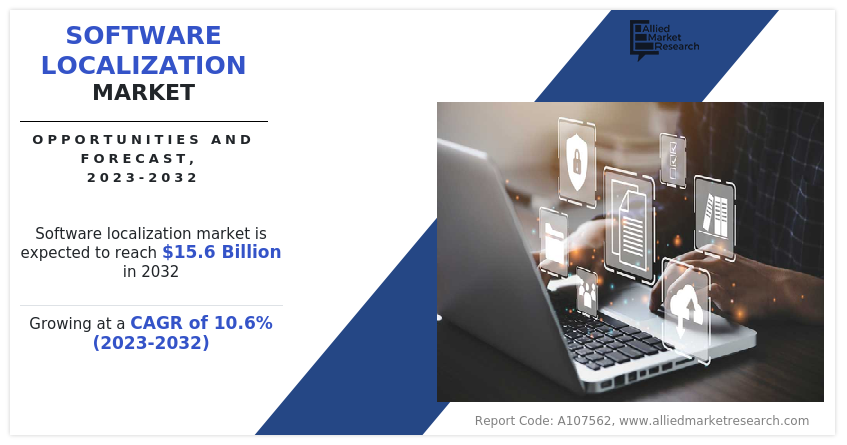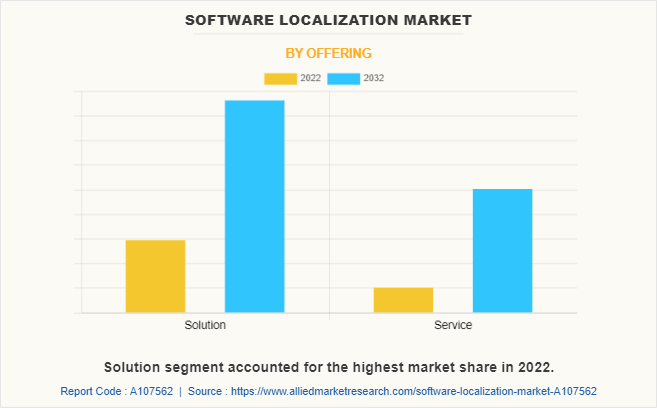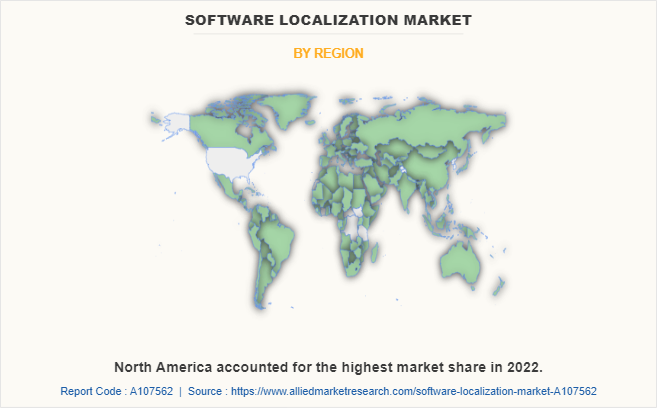Software Localization Market Insight, 2032
The global software localization market was valued at $5.9 billion in 2022, and is projected to reach $15.6 billion by 2032, growing at a CAGR of 10.6% from 2023 to 2032.
Software localization refers to the process of adapting software applications, websites, or digital content to meet the linguistic, cultural, and technical requirements of a specific target market or region. It involves translating and adapting various software elements, such as user interfaces, menus, dialog boxes, error messages, documentation, and multimedia content, to make them appropriate and understandable for users who speak different languages and belong to different cultures.

The increased concentration of businesses on global expansion is a key driver for the growth of the software localization market. Businesses across the world are concentrating on growing their global footprint. Software for localization aids businesses in growing their reach. Businesses are realizing the potential of reaching new markets beyond their domestic boundaries. Expanding into international markets allows companies to tap into larger customer bases, increase revenue streams, and reduce dependency on a single market. In addition, increasing demand for multilingual software is the major driving factor for the market.
However, lack of awareness and education about localization software is a major factor hampering the growth of the market as businesses may not understand the importance of linguistic and cultural adaptation, resulting in inadequate translations, inconsistent user interfaces, and unsatisfactory user experiences. This hinders the growth of the market as businesses fail to meet the localization standards required for successful market penetration. Contrarily, the growing need for localized mobile applications presents a significant opportunity for the software localization industry. Mobile apps play a significant role in the e-commerce industry. As businesses expand their reach to international markets, localized mobile apps become crucial for providing a seamless shopping experience. Localization ensures that product listings, pricing, payment options, and customer support are tailored to the target market, increasing customer trust, and facilitating cross-border transactions. Therefore, these factors are anticipated to create significant opportunities for the growth of the software localization market forecast.
The report focuses on growth prospects, restraints, and trends of the software localization market analysis. The study provides Porter’s five forces analysis to understand the impact of various factors, such as bargaining power of suppliers, competitive intensity of competitors, threat of new entrants, threat of substitutes, and bargaining power of buyers, on the software localization market.
Segment Review
The software localization market is segmented on the basis of offering, type, and end user. Based on offering, the market is segmented into solution, and service. Based on type, the market is segmented into computer-assisted translation software, machine translation software and translation management software. On the basis of end user, it is segmented into individual and enterprises. By region, it is analysed across North America, Europe, Asia-Pacific, and LAMEA.

By offering, the solution segment attained the highest growth in 2022. This is because the continuous advancements in technologies, such as cloud computing, artificial intelligence (AI), and automation are revolutionizing the software localization process. These innovations enable faster and more efficient localization, driving the growth of solutions that incorporate these technologies. Moreover, modern software applications are becoming more complex, with multiple components, platforms, and integrations. This complexity requires advanced localization solutions, including testing and quality assurance tools, to ensure the accuracy and functionality of localized software across different environments.
However, the service segment is expected to be the fastest growing segment during the forecast period. This is due to the growing emphasis on transcreation services, which go beyond literal translation to recreate content while maintaining their intended impact and emotional appeal. Creative adaptation ensures that localized software content resonates with the target audience and enhances user engagement.

On the basis of region, North America attained the highest growth in 2022. This was primarily because the software localization industry in North America has been experiencing steady growth due to the globalization of businesses and the expanding reach of software applications. As companies strive to enter international markets, the need for localized software to cater to diverse linguistic and cultural preferences has risen. Moreover, with advancements in machine translation and artificial intelligence, companies in North America are increasingly leveraging these technologies to streamline the software localization process. Machine translation, combined with post-editing by human translators, has become a common practice to accelerate the localization workflow and reduce costs.
However, Asia-Pacific is expected to be the fastest growing region during the forecast period. This growth is attributed to the demand for Asian language localization, such as Chinese, Japanese, Korean, and Southeast Asian languages, which is increasing in the Asia-Pacific region. International companies looking to enter these markets recognize the importance of providing localized software in the local language to effectively engage with users and gain a competitive advantage. Moreover, governments in the Asia-Pacific region have recognized the importance of technology adoption and digital innovation for economic growth.
The report analyzes the profiles of key players operating in the software localization market such as IBM, Microsoft, Lionbridge Technologies, LLC, SDL/Trados, Google, SYSTRAN, Babylon Corporation, The Babel Fish Corporation, Argos Multilingual, Alchemy Software Development Ltd. These players have adopted various strategies to increase their market penetration and strengthen their position in the software localization market size.
Top Impacting Factors
The Increased Concentration of Businesses on Global Expansion
The increased concentration of businesses on global expansion is a key driver fueling the global market for software localization. Businesses across the world are concentrating on growing their global footprint. Software for localization aids businesses in growing their reach. Businesses are realizing the potential of reaching new markets beyond their domestic boundaries. Expanding into international markets allows companies to tap into larger customer bases, increase revenue streams, and reduce dependency on a single market.
In addition, global expansion provides businesses with a competitive advantage by allowing them to enter markets where competitors may not have a strong presence. By localizing their software, companies can establish themselves as local players, gaining credibility and trust from customers. Providing software in the local language and adapting it to the local culture gives businesses an edge over competitors that offer generic, non-localized products. Furthermore, the increased concentration of businesses on global expansion fuels the demand for software localization as a strategic necessity to effectively enter, engage, and succeed in international markets.
Increased Demand for Multilingual Software
Multilingual software localization goes beyond mere translation of the user interface. It involves adapting the software to align with local cultures, conventions, and preferences. This includes not only language translation but also the customization of content, visuals, and features to cater to the specific needs and expectations of different regions. By ensuring cultural relevance, businesses can create a more immersive and personalized user experience. Moreover, multilingual software provides a competitive advantage in global markets. Businesses that invest in localization demonstrate a commitment to understanding and meeting the needs of users in different regions. By providing software in multiple languages, companies can differentiate themselves from competitors and gain a stronger foothold in the market. Multilingual software becomes a distinguishing factor that attracts users and positions businesses as global players.
In addition, multilingual software localization facilitates effective collaboration and communication in global teams and organizations. Distributed teams working across different regions can use localized software to communicate seamlessly in their preferred languages. This improves productivity, collaboration, and overall efficiency in global workflows. Therefore, multilingual software localization plays a crucial role in enhancing user engagement and retention. By providing a personalized, culturally relevant, and accessible experience, businesses can foster user satisfaction, trust, and loyalty. This ultimately leads to increased engagement levels, improved user retention rates, and positive brand advocacy.
Lack of Awareness and Education About Localization Software
One of the restraining factors in the software localization market is the lack of awareness and education about the importance and benefits of software localization. The lack of awareness and education about software localization can lead to incomplete or suboptimal localization efforts. Businesses may not understand the importance of linguistic and cultural adaptation, resulting in inadequate translations, inconsistent user interfaces, and unsatisfactory user experiences. This hinders the growth of the market as businesses fail to meet the localization standards required for successful market penetration.
In addition, when businesses are unaware of the benefits of software localization, they are less likely to seek out localization services. This limited demand for localization services can restrain the growth of the market as localization providers face challenges in expanding their client base and delivering their services to a wider range of businesses. Furthermore, the lack of awareness about software localization can result in limited adoption across industries. Businesses may not perceive localization as a crucial factor in their software development process, leading to a lack of demand for localization services.
The Growing Need for Localized Mobile Applications
Localization opens up opportunities for businesses to generate revenue from multiple markets. By making the app accessible to users in different countries, businesses can monetize their app through in-app purchases, subscriptions, advertisements, or other revenue models. Localized apps have a higher chance of attracting paying users and driving revenue growth. In addition, mobile app localization enables businesses to effectively engage with a global audience, increase app downloads, and generate revenue from diverse markets. By considering language, culture, and user experience, businesses can tailor their mobile apps to specific regions, gaining a competitive advantage and improving user satisfaction in international markets.
Furthermore, mobile apps play a significant role in the e-commerce industry. As businesses expand their reach to international markets, localized mobile apps become crucial for providing a seamless shopping experience. Localization ensures that product listings, pricing, payment options, and customer support are tailored to the target market, increasing customer trust and facilitating cross-border transactions. Therefore, these factors are anticipated to create significant opportunities for software localization market growth.
Market Landscape and Trends
With the proliferation of smartphones and mobile applications, the demand for mobile app localization has increased significantly. Companies are targeting specific regions and languages to localize their mobile apps and capture new user bases. This includes adapting the user interface, content, and functionalities of mobile apps to suit the preferences of local users. Moreover, the software development industry has embraced agile methodologies, such as DevOps and Continuous Integration/Continuous Deployment (CI/CD). Software localization is also adapting to these agile practices by integrating localization processes into the development cycle, allowing for faster and more efficient localization of software releases.
In addition, the advancements in machine translation and artificial intelligence (AI) had a significant impact on the software localization market share. AI-powered translation tools and language technology solutions are being integrated into the localization workflow to improve translation quality, efficiency, and consistency. Neural machine translation (NMT) models are increasingly being used to provide faster and more accurate translations. Therefore, the software localization market is constantly evolving, with new trends emerging as the technology advances.
Key Benefits for Stakeholders
- This report provides a quantitative analysis of the market segments, current trends, estimations, and dynamics of the software localization market analysis from 2023 to 2032 to identify the prevailing software localization market opportunities.
- The market research is offered along with information related to key drivers, restraints, and opportunities.
- Porter's five forces analysis highlights the potency of buyers and suppliers to enable stakeholders make profit-oriented business decisions and strengthen their supplier-buyer network.
- In-depth analysis of the software localization market segmentation assists to determine the prevailing market opportunities.
- Major countries in each region are mapped according to their revenue contribution to the global market.
- Market player positioning facilitates benchmarking and provides a clear understanding of the present position of the market players.
- The report includes the analysis of the regional as well as global software localization market trends, key players, market segments, application areas, and market growth strategies.
Software Localization Market Report Highlights
| Aspects | Details |
| Market Size By 2032 | USD 15.6 billion |
| Growth Rate | CAGR of 10.6% |
| Forecast period | 2022 - 2032 |
| Report Pages | 248 |
| By Offering |
|
| By Type |
|
| By End User |
|
| By Region |
|
| Key Market Players | SYSTRAN, Lionbridge Technologies, LLC, Babylon Software Limited, SDL, Argos Multilingual, Google LLC, Microsoft, The Babel Fish Corporation, Alchemy Software Development Ltd., IBM |
Analyst Review
The software localization market has experienced significant growth in recent years, and the trend is expected to continue. Cloud technology has revolutionized many aspects of software development, including localization. Cloud-based localization solutions offer scalability, flexibility, and collaboration capabilities, allowing software companies to streamline the localization process and reduce time to market. Moreover, the mobile app market continues to grow rapidly, and localization plays a crucial role in expanding the reach of mobile apps. Software companies are increasingly investing in mobile app localization to target global audiences and maximize their app's market potential. In addition, as software markets become more saturated, some companies are exploring localization for niche or specialized markets. By targeting specific industries or user segments, software companies can differentiate themselves and cater to unique localization requirements.
Furthermore, market players are adopting various strategies for enhancing their services in the market and improving customer satisfaction. For instance, in March 2023, Clearly Local announced partnership with Phrase to deliver superior localization solutions. Fast-growing content creation and translation solutions provider Clearly Local has partnered with Phrase, a global leader in cloud-based localization technology, to offer unparalleled localization solutions to its clients. The partnership marks a milestone for Clearly Local as the addition of Phrase’s leading-edge capabilities will provide the highest-quality localization solutions to businesses of all sizes across APAC. Moreover, in May 2020, world-class localization and translation service agency Acclaro announced a partnership with Lokalise, a localization and translation management platform for agile teams. Together, Acclaro and Lokalise provided unique and effective solutions for joint clients who were looking to expand their brands, products and services into new language markets.
Some of the key players profiled in the report include IBM, Microsoft, Lionbridge Technologies, LLC, SDL/Trados, Google, SYSTRAN, Babylon Corporation, The Babel Fish Corporation, Argos Multilingual, Alchemy Software Development Ltd. These players have adopted various strategies to increase their market penetration and strengthen their position in the software localization market.
The software localization market is estimated to grow at a CAGR of 10.6% from 2023 to 2032.
The software localization market is projected to reach $15.63 billion by 2032.
The increased concentration of businesses on global expansion, increased demand for multilingual software and the growing need for localized mobile applications majorly contribute toward the growth of the market.
The key players profiled in the report include software localization market analysis includes top companies operating in the market such as IBM, Microsoft, Lionbridge Technologies, LLC, SDL/Trados, Google, SYSTRAN, Babylon Corporation, The Babel Fish Corporation, Argos Multilingual, Alchemy Software Development Ltd.
The key growth strategies of software localization players include product portfolio expansion, mergers & acquisitions, agreements, geographical expansion, and collaborations.
Loading Table Of Content...
Loading Research Methodology...



